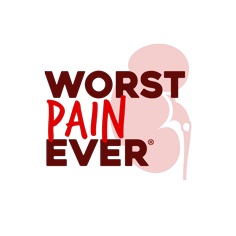1. Size of your stone
If your stones are smaller than 5mm, you are likely to pass them out in 4 to 6 weeks1 with the help of some medication (such as alpha blockers like Tamsulosin) and painkillers.
If your kidney stones are larger than 5mm, there’s a chance they may get stuck in your ureter. This puts you at risk of developing complications like a urinary tract infection. In such cases, you may have to undergo a procedure to get rid of your stones.
For stones smaller than 20mm, your urologist may recommend you undergo shock wave lithotripsy (ESWL) or ureteroscopy (URS)2. ESWL is a non-invasive treatment while URS is a minimally invasive treatment. However, the good news is that both treatments require little to no hospital stay!
For complex stones (e.g. staghorn stones) or stones larger than 20mm, percutaneous nephrolithotomy (PCNL) is the gold standard for kidney stone treatment3. Though slightly more invasive than ESWL or URS, PCNL is effective in treating all your stones and removing remaining stone fragments in just one session4.
2. Location of your stone
Your urinary system comprises of four main parts: your kidneys, ureters, bladder and urethra. The ureters connect your kidneys to the bladder.
Generally, if your stones are located lower in your ureter (i.e. closer to your bladder), you stand a higher chance of passing them naturally. However, they may still get stuck, which is when you are required to undergo a procedure.
If you have smaller stones (<10mm) in the upper area of your kidney, you may be a good candidate for ESWL5. However, if your stones are in the lower part of your kidney or ureters, your urologist may recommend URS instead.
On the other hand, PCNL is the ideal procedure for larger or complex (e.g. staghorn) stones, regardless of its location in your urinary system.
3. Duration and severity of your symptoms
A kidney stone can cause severe pain, especially when it gets stuck in your ureters.
If you’ve taken painkillers and are still experiencing pain to the point where you can’t eat or drink, your urologist may suggest that you undergo diagnostic tests (e.g. CT scans and/or ultrasounds). Your stone imaging results will help your urologist determine the best treatment for your case.
4. Infection in your upper urinary tract
If you have a history of chronic kidney infections, your urologist may recommend URS or PCNL, instead of ESWL. ESWL uses shockwaves to break your stones into smaller fragments so you can pass them on your own6. However, this increases the risk of fragments getting stuck in your ureter, causing bacteria to remain in your kidney7.
If you’re battling an active urinary infection, getting sepsis post-surgery is a possibility. You will most likely be treated prior to URS or PCNL8.
5. Other medical factors
Your treatment plan can also depend on your medical history. If you’re suffering from certain health issues, some treatments could pose more risks due to the techniques used.
For example, if you have a bleeding disorder, URS and PCNL are the first-line treatment for kidney stones.
On the other hand, patients with illnesses such as chronic renal failure (CRF) should undergo PCNL over other procedures. In these cases, ESWL and URS can be dangerous as residual kidney stone fragments may cause bacteria to multiply7, which can pose a significant health risk.
6. Urologist’s specializations
Your urologist’s specialization matters more than you think!
Just because your urologist specializes in kidney stone disease doesn’t necessarily mean they specialize in all kidney stone procedures. For example, some urologists specialize in ESWL, while others specialize in URS or PCNL. Based on their experience, they may recommend certain treatment options over others!
In summary
A lot of thought and consideration goes into your urologist’s treatment recommendation. Discuss your treatment preferences with them, and don’t be afraid to ask questions about the rationale behind their suggestions!
Sources:
- Rule, A. D., Lieske, J. C., & Pais, V. M. (2020). Management of kidney stones in 2020. JAMA, 323(19), 1961-19
- Fankhauser, C. D., Hermanns, T., Lieger, L., Diethelm, O., Umbehr, M., Luginbühl, T., … & Poyet, C. (2018). Extracorporeal shock wave lithotripsy versus flexible ureterorenoscopy in the treatment of untreated renal calculi. Clinical kidney journal, 11(3), 364-369.
- Flannigan, R., Choy, W. H., Chew, B., & Lange, D. (2014). Renal struvite stones—pathogenesis, microbiology, and management strategies. Nature reviews Urology, 11(6), 333-341.
- Xiao-jian, G., Jian Lin, L., & Yan, X. (2013). Treatment of large impacted proximal ureteral stones: randomized comparison of minimally invasive percutaneous antegrade ureterolithotripsy versus retrograde ureterolithotripsy. World journal of urology, 31(6), 1605-1610.
- Johns Hopkins Medicine. (2022, February 3). Extracorporeal shock wave lithotripsy (ESWL). Johns Hopkins Medicine. Retrieved October 7, 2022, from https://www.hopkinsmedicine.org/health/conditions-and-diseases/kidney-stones/extracorporeal-shock-wave-lithotripsy-eswl
- Williams, J. (2020, November 16). High rate of residual fragments seen after Urs. Urology Times. Retrieved October 7, 2022, from https://www.urologytimes.com/view/high-rate-residual-fragments-seen-after-urs
- Zeng, T., Chen, D., Wu, W., Huang, Y., Zhang, S., Zhao, Z., … & Wu, W. (2020). Optimal perioperative antibiotic strategy for kidney stone patients treated with percutaneous nephrolithotomy. International Journal of Infectious Diseases, 97, 162-166.
- Gopalakrishnan, G., & Prasad, G. S. (2007). Management of urolithiasis with chronic renal failure. Current Opinion in Urology, 17(2), 132-135.





